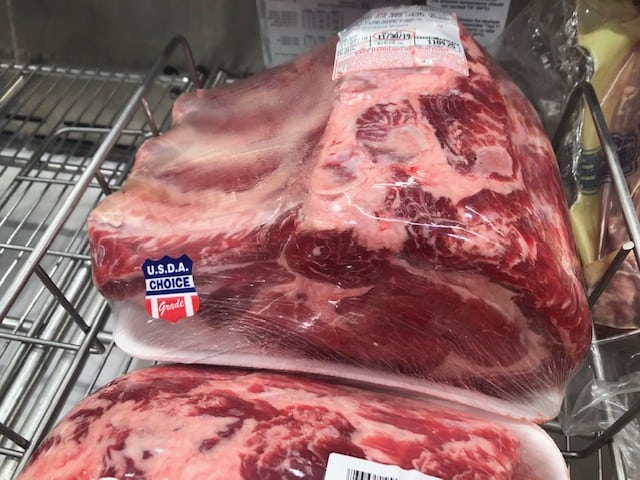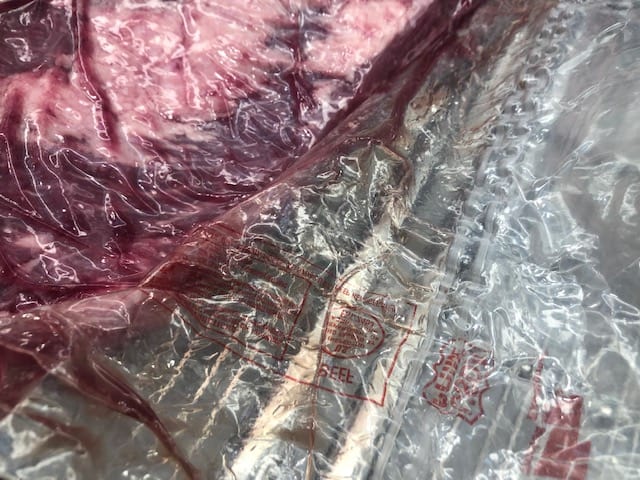The technique for wet ageing beef at home is incredibly simple. The trick is to understand which cuts of beef benefit from wet aging, how long the beef can be wet aged and how to handle the beef when the process is over.
Wet ageing beef helps beef become more tender as the natural enzymes in the muscles will slowly break down the fibers. Wet ageing is perfect for tough cuts like brisket and helps improve the tenderness of Select grade ribeyes and strip loins.

Wet ageing is performed almost exclusively for improved tenderness. There is no point in wet ageing beef tenderloins as they are already incredibly tender. Wet aging does not impact the flavor profile of beef in the way you get from dry ageing.
How To Wet Age Beef
- Purchase a large subprimal cut of beef that is sealed in cryovac.
- Place the beef in a refrigerator set at 35F.
- Turn the beef over once per week while it is aging.
- Let the beef age for 45-60 days.
Let’s look at each of these steps in more detail.
Buy The Right Beef
You must buy beef that is still sealed in the original cryovac. These will be cuts like a whole packer brisket, ribeye roll or sirloin clod.

This technique WILL NOT WORK with individual steaks or roasts that have been taken out of the cryovac, trimmed by the butcher, placed on a styrofoam tray and covered with plastic wrap.

When you are wet aging beef, the oxygen in the air is your enemy and as soon as the seal on the cryovac is broken the game is over.
Place the Beef In A Refrigerator
On one hand this part is really simple. Stick the beef, still in the cryovac, into your refrigerator, close the door and walk away.
I use my regular kitchen refrigerator when I wet age brisket but many of the competition barbecue teams use a dedicated refrigerator just for wet aging briskets. The competition teams use dedicated refrigerators because they have to wet age a LOT of briskets at staggered dates to make sure they have a steady supply throughout the competition season.
You want the temperature of the refrigerator to be as close to 35F as possible. If your refrigerator is too cold ( 32F or lower) you run the risk of slowly freezing the beef which will shut down the enzymes that should be making the beef tender. If the temperature is too high (40F or higher) then you run the risk of spoilage as you are in the temperature range when harmful bacteria becomes active.
Please do not assume that just because your day to day food staples look okay that your refrigerator is at the right temperature. Things like a gallon of milk will typically only be in the refrigerator for a few days or a week where the impacts of a bad temperature setting are not that pronounced. The beef is going to be in that refrigerator for up to two months and the effect of the wrong temperature will be pronounced!
Turn the Beef Once Per Week
When I wet age briskets I like to turn them over once per week.
One reason I flip the briskets is to even out the pressure. I don’t know if this matters or not but I feel like if a heavy cut of beef is lying on the same side for two months then the side on the bottom is going to get “pressed”. I like to flip the thing just to even out which side is receiving pressure on the bottom. Again, I have no idea if this is important or not but it sure doesn’t hurt.
The real benefit of flipping the meat over is that it makes me inspect the beef on a regular basis. This is when I check to make sure none of it has been partially frozen by a cold spot in the refrigerator. This is when I check to make sure that the seal on the cryovac is still intact.

How Long Should You Wet Age Beef?
My target time for wet aging is between 45 and 60 days.
The lower end of 45 days is based on the collective wisdom of the competition barbecue community. This, in general, is the minimum amount of days required to get a real difference in tenderness. These are big hunks of meat being stored at low temperatures and it just takes a while for those enzymes to work their magic.
The upper end of 60 days is based upon my personal comfort level. I am perfectly comfortable aging a prime brisket for 60 days. I don’t like to push it further than this because I don’t want to run the risk of ruining an absolutely perfect cut of beef. In my opinion there is not much to be gained by aging longer than 60 days but there is a whole lot to lose.
I settled on my 60 day upper limit after reading that researchers from Certified Angus Beef had found increased tenderness in wet aged ribeyes and strip loins at the 60 day mark. This was the same article that established wet aging for 6 months was a train wreck! Here is a link to the article if you would like to read it.
What Do You Do After Wet Aging?
Okay, you have wet aged your beef for 45-60 days…now what? You have a couple of options at this point.
If you are not ready to cook your aged brisket you can put it in the freezer and store it another month or two until you are ready to put it on the pit. The meat will not continue to age as the process of freezing shuts down the active enzymes.
If you are ready to start cooking then open up the cryovac, remove the meat and rinse it off. When you first open the cryovac your nose is going to be hit with a bit of a funky smell that might make you stand back 🙂 That’s okay and perfectly normal. Once you discard the cryovac, rinse and dry the meat the smell will subside considerably.
If at this point the meat smells AWFUL then something has gone wrong and the beef should be discarded. A little funk is okay. A lot of awful is not okay.
If you have aged a ribeye or strip loin then, after rinsing and drying, you can cut individual steaks and either cook them now or vacuum seal them and freeze for later use. Do not worry about freezing the steaks…if you use a vacuum sealer and thaw them slowly in the refrigerator then they will still be spectacular.


